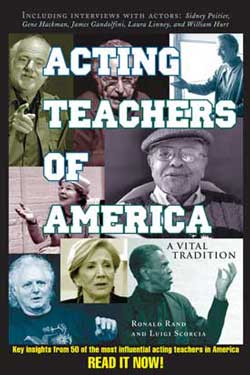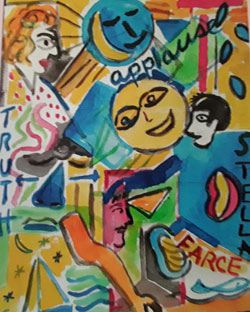Martha Carpenter
 Considered one of the premiere portrait artists of America, Ms. Carpenter has had her paintings exhibited across America, as well as at the Centre International D’Art Contemporain in Paris, France as a participant in a Salon des Nations Exhibition promoting independent American artists. Throughout her career, Ms. Carpenter has had numerous exhibition experiences and publications, which have culminated in a consistent influx of private and corporate portrait commissions. Currently, her work is marketed nationwide through galleries, agencies and private exhibitions. Ms. Carpenter received the Certificate of Recognition as the Winner of Portrait Society of America International Competition in 2001.
Considered one of the premiere portrait artists of America, Ms. Carpenter has had her paintings exhibited across America, as well as at the Centre International D’Art Contemporain in Paris, France as a participant in a Salon des Nations Exhibition promoting independent American artists. Throughout her career, Ms. Carpenter has had numerous exhibition experiences and publications, which have culminated in a consistent influx of private and corporate portrait commissions. Currently, her work is marketed nationwide through galleries, agencies and private exhibitions. Ms. Carpenter received the Certificate of Recognition as the Winner of Portrait Society of America International Competition in 2001.
How did it happen you began painting?
Photo by Mary Jane Starke
It was a gift that I discovered when I was a child. I still consider it a gift, and I’m continuing to discover it more every day.
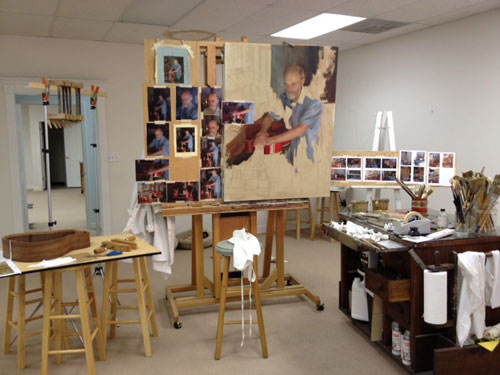
When did you know you wanted to be a portrait painter?
When I was a young child I drew people; I don’t know why. Sometimes I think about that. I wonder about my quest for painting portraits. Because I’m a little bit of an introvert, maybe it’s my way of communicating.
How did you develop your style?
If I have a style it’s not by design. It’s just the way my hand moves across the canvas, the way my eyes see the subject matter, and how it’s translated onto the canvas. I like for the painting to have a fresh quality. Sometimes I strive to leave certain brushstrokes unhampered and not manipulated after they have been applied to the canvas.
A lot of master painters have practiced that effectively. I’m a student of John Singer Sargent. I’ve been inspired by certain artists who painted a certain way. Every individual artist will inevitable have what, one would call, style. I don’t know if it’s always intentional; it happens by nature.
What do you find in John Singer Sargent’s portraits that make such a deep impression on you?
He was master painter; it’s the longevity of his work. If you stand in front of his painting, it’s very captivating. His subjects are portrayed in a magical way. His composition and lighting, the scale of the paintings, the way he connects with the viewer, all have an impact as portrayed by his mastery of the medium. He was a very gifted portrait artist
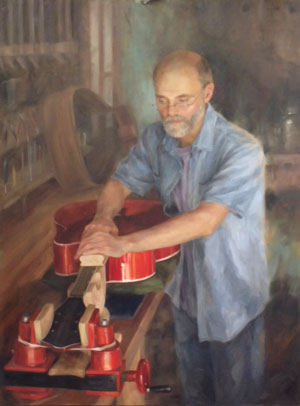 It’s also Sargent’s color. One day I was looking at a painting of his – of a woman in white. She had on a dress which appeared to be of a satin material. It was a gorgeous rendition of this white color in the painting of her garment. Well, I took a white envelope from my purse, and I held it up in front of the white in his painting, but the color in his painting was clearly more like gray. However, when you stepped back, the painting of the dress clearly looked like white.
It’s also Sargent’s color. One day I was looking at a painting of his – of a woman in white. She had on a dress which appeared to be of a satin material. It was a gorgeous rendition of this white color in the painting of her garment. Well, I took a white envelope from my purse, and I held it up in front of the white in his painting, but the color in his painting was clearly more like gray. However, when you stepped back, the painting of the dress clearly looked like white.
I knew that’s what I wanted to be able to achieve, that kind of an illusion. He has used color intensities and color values to achieve this white color in the painting.
If you examine the rhythm of his brushwork, it’s like Argentine tango. In one of his paintings, you can see his fiery brush work in a woman standing outdoors, and then in her face, it’s done with such total refinement and sensitivity. There’s another place where you can see his paint brush bristles. They must have been coming apart. When that happens to my brushes when I’m painting, I also leave them on the canvas. In his painting, it’s all there – like a time capsule. Portraits continue to intrigue the viewer because it’s a human image and because of the communication that occurs.
Are there certain artists that have influenced your work?
Yes – many artists – some are living today and some have passed on decades ago. I look at art books, studying artists work, but I’ve strongly influenced by other portrait artists of today.
What kinds of materials do you prefer to paint on and what brushes do you use?
I use a Belgian linen canvas, primed by an individual in New York who uses a special primer. I’ve never met him but all I know is his name in Angel. I don’t use products that are available through art supply sources; I’m particular about the priming techniques. The linen comes from the flax plant, the fibers are longer, making it a much stronger fabric adding to the life of the painting. More than likely paintings by van Gogh and da Vinci and Michelangelo were painted on linen.
The brushes I use are filbert brushes. They’re curved, like the human form is a curved form.
Do you normally paint your paintings with the person sitting for you?
I’ve done a multitude of portraits from life which is preferable, but I also have done a lot of major works by means of photographic reference which I execute myself. If the painting have to be done using photographs, it’s better that the artist does the photography.
The reason the old master works are so incredibly amazing is because they were done from life. In doing a great painting from life, all the information is right there before your eyes. Looking at a photo is an illusion, not to scale, and two-dimensional; whereas the human form is three-dimensional.
Your paintings must hold great meaning for those who have commissioned you –
A mother who had commissioned me to paint her daughters had traveled to Chicago to a doll show by train. Terribly, tragically there was a crash, and the mother lost two of her daughters on the train. It was terrible.
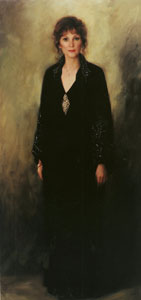 I was told both parents had done an interview, and when I watched it on television, the father and mother talked about what helped them get through. Their daughters were so beautiful. And as the mother was interviewed, she spoke about her faith in getting through this terrible tragedy, and they showed the portrait painting I had done of the two daughters. She talked about how much it meant to her to have the painting. Hearing that made me feel very worthwhile and gave a whole new meaning to me of what my work can mean for others.
I was told both parents had done an interview, and when I watched it on television, the father and mother talked about what helped them get through. Their daughters were so beautiful. And as the mother was interviewed, she spoke about her faith in getting through this terrible tragedy, and they showed the portrait painting I had done of the two daughters. She talked about how much it meant to her to have the painting. Hearing that made me feel very worthwhile and gave a whole new meaning to me of what my work can mean for others.
A similar experience happened when I had been commissioned and had painted individual portraits of four children of a family who, while on a safari in Africa were killed in a plane crash. The grandfather had chartered a tour by plane for the entire family. Only one child who was too young to go stayed behind with the nanny. When this child was left orphaned she was adopted by family members. The commission to paint this last child in the family had already been contracted so eventually I completed the series of portraits. I feel portrait paintings are a very effective way to document a life. It’s a very humanistic art form.
What does it take to be a painter of portraits?
 Sacrifice. When one enters the studio to put in a day of work, you go to the easel to do a painting. As a portrait painter you don’t have ownership; you have a commission. You’re painting a document of an individual, whether it’s a child or the President of the United States. It has to cater to a client. You receive a down-payment and its someone else’s painting from the start. You sacrifice an amount of artistic freedom; a different faculty of the mind is employed.
Sacrifice. When one enters the studio to put in a day of work, you go to the easel to do a painting. As a portrait painter you don’t have ownership; you have a commission. You’re painting a document of an individual, whether it’s a child or the President of the United States. It has to cater to a client. You receive a down-payment and its someone else’s painting from the start. You sacrifice an amount of artistic freedom; a different faculty of the mind is employed.
So it requires patience. Sometimes you have to dig into your soul because it’s always the end result that matters. You have to have an accurate portrayal of the subject, and requires more patience that you think you have.
What gives you your greatest joy in painting?
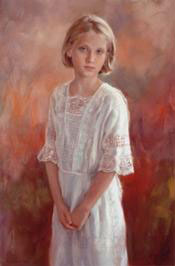 The fulfillment of a successful painting. The fact that it’s all I am. It makes me feel grateful, blessed. I was given this chance to paint and it’s been there as my companion, my livelihood. Sometimes I compare academic painting to the sports world when you perform well, it gives you joy. Whenever I place a painting in a home or an institution since I know it will be appreciated and make someone happy; that gives me a lot of gratification.
The fulfillment of a successful painting. The fact that it’s all I am. It makes me feel grateful, blessed. I was given this chance to paint and it’s been there as my companion, my livelihood. Sometimes I compare academic painting to the sports world when you perform well, it gives you joy. Whenever I place a painting in a home or an institution since I know it will be appreciated and make someone happy; that gives me a lot of gratification.
Doing a recent painting, “The Luthier” was refreshing. It’s the title used to describe the craft of the man in the painting, he makes guitars. I thought it would be interesting to show a crafts person in their craft. It wasn’t commissioned, and my brushwork was more deliberate, it had more freedom.
Is there a way to develop one’s appreciation or taste for art?
I think Harold Clurman had it in a nutshell when he wrote in a commentary about the theater: If it touched people, it was a good play.
It’s very relative, isn’t it? They say beauty is in the eye of the beholder. Some may see it in a Rothko or a Picasso which are entirely different from a Botticelli or a Michelangelo due to style, color and tone and content. A person can be affected by the skill level or the emotion it conjures up and it gives tremendous meaning to the viewer.
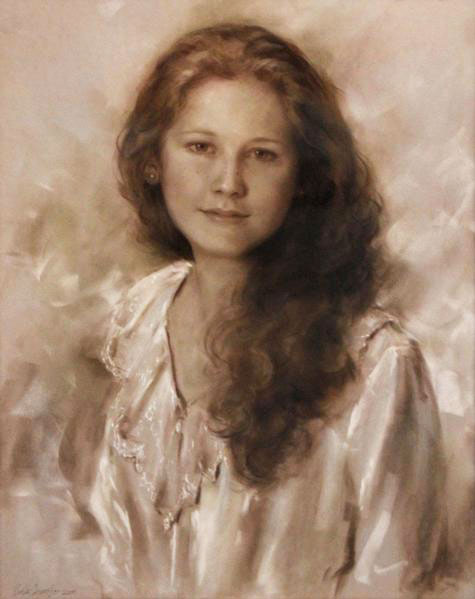
When I see a strong painting by John Singer Sargent, I react in a great way to the various colors, the values, and the color temperature in the painting, how he achieved what he did.
 In terms of a particular painting of mine: there was a painting I was commissioned to do. Although it never got any recognition, and it’s just a young girl about twenty years of age with long blonde hair. She didn’t really get dressed up. But in my mind it’s one of the best paintings I ever did. No one would know that. It’s because it just flowed, every brushstroke was purposeful and the paint went on the way I intended, and the end result was a real fresh final affect; it was all very direct brushstrokes.
In terms of a particular painting of mine: there was a painting I was commissioned to do. Although it never got any recognition, and it’s just a young girl about twenty years of age with long blonde hair. She didn’t really get dressed up. But in my mind it’s one of the best paintings I ever did. No one would know that. It’s because it just flowed, every brushstroke was purposeful and the paint went on the way I intended, and the end result was a real fresh final affect; it was all very direct brushstrokes.
The way I had painted – alla prima – “all at once.” You make the brushstroke and leave it there. You know why it’s there and you know the reason you made it.
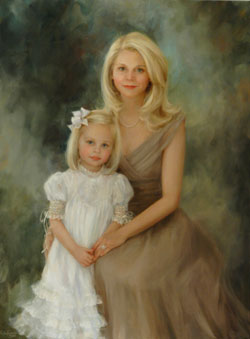 I can think of paintings with tremendous brush work: works by Goya, Velázquez, John Singer Sargent, William Merritt Chase. I’m amazed by all of these artists who invested a lifetime in their art form. If anyone is able to invest a lifetime of pursuing an art form in a serious nature, not just for fame, can create something great, whether it’s a dance or a piece of music or a piece of art or a performance or a play for the theater – it’s about the process – that’s what makes it great.
I can think of paintings with tremendous brush work: works by Goya, Velázquez, John Singer Sargent, William Merritt Chase. I’m amazed by all of these artists who invested a lifetime in their art form. If anyone is able to invest a lifetime of pursuing an art form in a serious nature, not just for fame, can create something great, whether it’s a dance or a piece of music or a piece of art or a performance or a play for the theater – it’s about the process – that’s what makes it great.
Creation takes a lot of willpower and can drive you crazy. You can get knocked down time and time again so it requires a great deal of stamina. You have to be willing to really work hard to build a foundation or a career, and then when you do have a career, what it takes to keep it going.
What makes art important in your life and in the life we live on this planet?
 In my case, it’s always been a good friend, a child, a companion and a partner. I think an artist is born with a need, a quest for beauty – be it a poet, a writer, an actor, a musician, a painter, all the artistic disciplines – in pursuing an art form, it helps us ride above the normal circumstances of the day. We have a constant quest for beauty and understanding achievement – and a God-given opportunity – if we can take advantage of it throughout our lives. It gives us a sense of worth; and it does take a lifetime. You don’t just acquire it getting up one day and acquire skill and produce a great work of art. Creation takes a lot of willpower.
In my case, it’s always been a good friend, a child, a companion and a partner. I think an artist is born with a need, a quest for beauty – be it a poet, a writer, an actor, a musician, a painter, all the artistic disciplines – in pursuing an art form, it helps us ride above the normal circumstances of the day. We have a constant quest for beauty and understanding achievement – and a God-given opportunity – if we can take advantage of it throughout our lives. It gives us a sense of worth; and it does take a lifetime. You don’t just acquire it getting up one day and acquire skill and produce a great work of art. Creation takes a lot of willpower.
To an artist it is life. It’s how we live Our art forms become our life. It’s You said you hadn’t been acting for a while, I’ve been busy with other things I haven’t painted in a short while, it feels unnatural. But like I said, we get to a point where we have a lot of work behind us, and we’re at a level which allows one to either to teach, or share what we’ve been given – or venture into a new level of performance and expression.•
“If I look for words, everything I do will always be invalid. I am condemned to use them because I am condemned to say something about the not-human world, the world as it is; this is the acceptable way to pass something to you, to communicate. The world as it is: this is the world of stars, the world of trees, of water; and I say this with words. I can touch this world when I am as original as a tree, or a star, or water. But to say this makes this invalid. It is not exact.” - Jerzy Grotowski
























